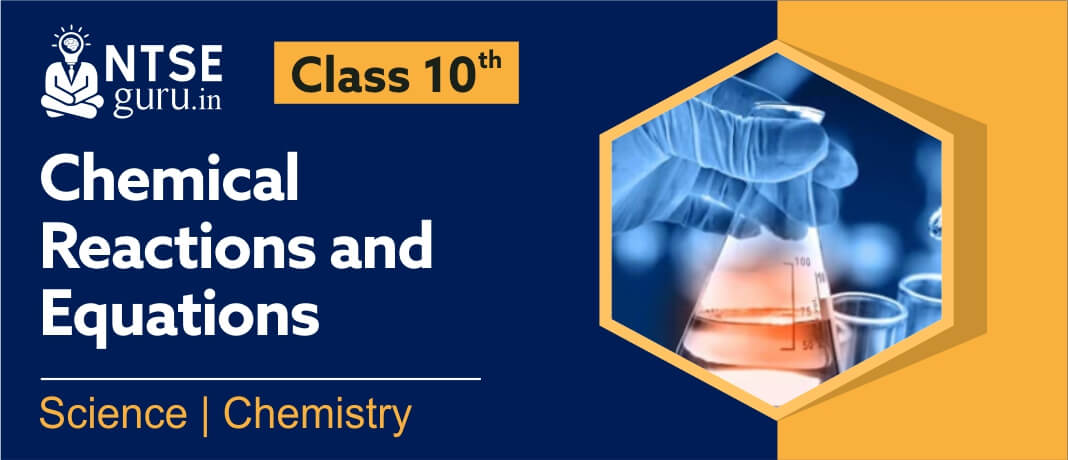Gender Religion And Caste Class 10 CBSE
Gender, Religion and Caste is an important chapter of Civics Class 10. It is Chapter 4 of your ...


Class 10 Science Chapter 1 in NCERT deals with the basics of chemical reactions and their representation in form of chemical equations. The Chemical Reaction and Equation Class 10 Chapter also includes writing balanced chemical equations along with important conditions of temperature and pressure.
The chapter also deals with the classification of reactions in four different types i.e. combination, decomposition, displacement and double displacement. Also, the importance of the reactivity series and its application while deciding the product of the reaction is discussed. The Chemical Reaction and Equations Class 10 chapter includes detailed insight on redox reactions and their application in daily life dimensions including respiration, corrosion and rancidity.
NTSEguru helps you to boost your preparation with the most probable questions in accordance with the revised pattern of X board examination by our expert team of faculties.
Have a great time learning with us!
1. What do you mean by a chemical equation? Give example also.
Ans. Chemical equation is a shorthand representation of a chemical reaction, with the help of symbols and formulae of reactants and products.
Example: The chemical equation for burning of Magnesium in air is :
\( 2M{{g}_{(s)}}+{{O}_{2}}_{(g)}\xrightarrow{{}}\,2Mg{{O}_{(s)}}\)
2. (a) What are the advantages of chemical equation
(b) What are the limitations of chemical equation?
Ans. (a) Advantages of using a chemical equation:
1.The representation of a chemical reaction becomes easy. It saves time and space in writing.
2.In order to prepare a definite amount of the product, the amount of the reactant to be used can be calculated accurately.
3. The same chemical symbols are used all over the world and, therefore, scientists face no difficulty in understanding chemical equations.
4. From a completely balanced chemical equation it becomes easy to determine the effect of temperature, pressure and concentration on the state of a reaction.
(b) Limitations of chemical equations:
1. A chemical equation does not indicate the physical state of the reactants and the products, i.e., it does not say whether the substances involved in the reaction are solids, liquids or gases.
2.It does not indicate whether heat is evolved or absorbed as a result of reaction, i.e., it does not say whether the reaction is exothermic or endothermic.
3.It does not indicate the conditions of the reaction, i.e., it gives no idea about the pressure, temperature, concentration, presence of catalyst, etc., under which the reaction may occur.
4.It does not indicate whether the reaction is fast or slow.
5. Some reactions occur with an explosion. This is not indicated by the chemical equation.
6. It does not say anything about the actual amount of the reactants consumed or products formed. It gives only the ratio.
3. Balance the following chemical equations:-
(i) \(Fe\,+\,{{H}_{2}}O\to F{{e}_{3}}{{O}_{4}}+{{H}_{2}}\) (ii) \({{C}_{6}}{{H}_{12}}{{O}_{6}}+{{O}_{2}}\to C{{O}_{2}}+{{H}_{2}}O\)
(iii) \(CO+{{H}_{2}}\to C{{H}_{3}}OH\) (iv) \(HN{{O}_{3}}+Ca{{\left( OH \right)}_{2}}\to Ca{{\left( N{{O}_{3}} \right)}_{2}}+{{H}_{2}}O\)
(v) \(NaOH+{{H}_{2}}S{{O}_{4}}\to N{{a}_{2}}S{{O}_{4}}+{{H}_{2}}O\) (vi) \(NaCl+AgN{{O}_{3}}\to AgCl+NaN{{O}_{3}}\)
(vii) \(BaC{{l}_{2}}+{{H}_{2}}S{{O}_{4}}\to BaS{{O}_{4}}+HCl\) (viii) \(Mn{{O}_{2}}+HCl\xrightarrow{{}}MnC{{l}_{2}}+{{H}_{2}}O+C{{l}_{2}}\)
Ans. (i) \(Fe\,+\,{{H}_{2}}O\to F{{e}_{3}}{{O}_{4}}+{{H}_{2}}\)
Select the biggest formula and balance its different elements.
The biggest formula is Fe3O4. We start balancing with the elements having maximum number of atoms.
Now, we start balancing with oxygen.
Oxygen atoms L.H.S. R.H.S.
Initially 1 4
To balance \( \xrightarrow{{}}\) \(4\times 1\) 4
To balance Oxygen, we need to multiply H2O in L.H.S. by 4. We get –
\(Fe+4{{H}_{2}}O\xrightarrow{{}}F{{e}_{3}}{{O}_{4}}+{{H}_{2}}\)
Now, to balance Fe atoms
Fe atoms L.H.S. R.H.S.
Initially 1 3
To balance \(3\times 1\) 3
To balance Fe, we need to multiply Fe in L.H.S. by 3. We get –
\(3Fe+4{{H}_{2}}O\xrightarrow{{}}F{{e}_{3}}{{O}_{4}}+{{H}_{2}}\)
Now hydrogen is the only element which is unbalanced. To balance hydrogen atom;
Hydrogen atoms L.H.S. R.H.S.
Initially 8 2
To balance 8 8
To balance Hydrogen, we need to multiply Hydrogen in R.H.S. by 4. We get –
\(3Fe+4{{H}_{2}}O\xrightarrow{{}}F{{e}_{3}}{{O}_{4}}+4{{H}_{2}}\)
Checking the correctness of the balanced chemical equation –
|
Element |
No. of atom in Reactants (L.H.S.) |
No. of atom in Products (R.H.S.) |
|
Fe |
3 |
3 |
|
O |
4 |
4 |
|
H |
8 |
8 |
Thus, the above equation is balanced. Similarly, other equations can be balanced.
(ii) \({{C}_{6}}{{H}_{12}}{{O}_{6}}+6{{O}_{2}}\xrightarrow{{}}6C{{O}_{2}}+6{{H}_{2}}O\)
(iii) \(CO+2{{H}_{2}}\xrightarrow{{}}C{{H}_{3}}OH\)
(iv) \(2HN{{O}_{3}}+Ca{{\left( OH \right)}_{2}}\to Ca{{\left( N{{O}_{3}} \right)}_{2}}+2{{H}_{2}}O\)
(v) \(2NaOH+{{H}_{2}}S{{O}_{4}}\to N{{a}_{2}}S{{O}_{4}}+2{{H}_{2}}O\)
(vi) \(NaCl+AgN{{O}_{3}}\to AgCl+NaN{{O}_{3}}\)
(vii) \(BaC{{l}_{2}}+{{H}_{2}}S{{O}_{4}}\to BaS{{O}_{4}}+2HCl\)
(viii \(Mn{{O}_{2}}+4HCl\xrightarrow{{}}MnC{{l}_{2}}+2{{H}_{2}}O+C{{l}_{2}}\)
4. (a) What information does the following chemical reaction carry?
\(C{{O}_{\left( g \right)}}+2{{H}_{2}}_{\left( g \right)}\xrightarrow{340\,atm}\,\,C{{H}_{3}}O{{H}_{\left( l \right)}}\)
(b) What are these notations \(\left( g \right)\,,\,\left( l \right),\,\,\left( aq \right)\,\And \,\left( s \right)\) represent?
(c) What are these called as?
(a) The given reaction shows that carbon monoxide (CO) gas reacts with Hydrogen gas \({{H}_{2}O}\) at 340 atmospheric pressure to form \({C{H}_{3}OH}\) (Methanol). Methanol is obtained in liquid state.
(b) Notation (g) represents gaseous state, (l) represents liquid state, (aq) stands for aqueous and (s) represents solid state of reactants and products in a chemical equation.
(c) These are called as state symbols.
5. How do we get energy from food? Write the main chemical reaction involved in the process.
Ans. The food such as rice, potatoes and breads contains carbohydrates. During digestion, they are broken down into simpler substances, such as glucose. The air we breathe in during respiration supplies oxygen and thus oxidizes glucose in the cells of our body. This reaction is exothermic and provides us with the required energy.
\(\begin{align} & {{C}_{6}}{{H}_{12}}{{O}_{6}}(aq)+6{{O}_{2}}(g)\to 6C{{O}_{2}}(g)+6{{H}_{2}}O(l)+Energy \\ & \text{Glucose} \\ \end{align} \)
Gender Religion And Caste Class 10 CBSE
Gender, Religion and Caste is an important chapter of Civics Class 10. It is Chapter 4 of your ...
Board exams for class X are around the corner and now it's high time to revise all the important concepts and related ...